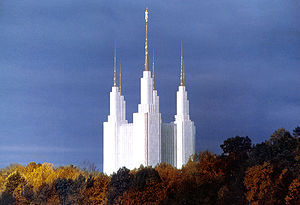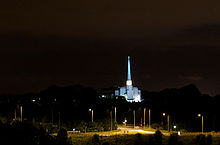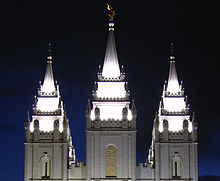- Temple (LDS Church)
-
This article is about temples in the LDS Church. For information about temples in the wider Latter Day Saint movement, see Temple (Latter Day Saints).For other uses, see Temple (disambiguation).
In The Church of Jesus Christ of Latter-day Saints (LDS Church), a temple is a building dedicated to be a House of the Lord, and they are considered by Church members to be the most sacred structures on earth. Upon completion, temples are usually open to the public for a short period of time (an "Open House"). During the Open House, the church conducts tours of the temple with missionaries and members from the local area serving as tour guides, and all rooms of the temple are open to the public. The temple is then dedicated as a "House of the Lord", after which only members who are deemed worthy are permitted entrance. Thus, they are not churches but rather places of worship.[1] The church is a prolific builder of temples as temples hold a key place in LDS theology. There are 135 operating temples, 13 under construction, and 18 announced (not yet under construction). At present, there are temples in many U.S. states, as well as in many countries across the world. Several temples are at holy sites of the LDS church, such as Nauvoo, Illinois and Palmyra, New York. The importance of temples is often emphasized in weekly meetings, and regular participation in temple work is strongly encouraged of all Latter-day Saints (LDS).
• = Operating temples • = Temples under construction • = Announced temples ▪ = Wasatch Front, Utah area temples
(ie. SLC area: 9: Oper.; 2:Under Const.; 1: Announ.)• = Temples closed, destroyed, operated by others, or efforts suspended. Within temples, members of the Church make covenants, receive instructions, and perform sacred ceremonies and ordinances, such as: baptism for the dead, washing and anointing (or "initiatory" ordinances), the "endowment", and eternal marriage sealings. Ordinances are a vital part of the theology of the church, which teaches that they were practiced by the Lord's covenant people in all dispensations. Additionally, members consider the temple a place to commune with God, seek God’s aid, understand the will of God, and receive personal revelation.
Contents
History
Biblical references - Old Testament
Latter Day Saints cite various Old Testament references to temple ordinances such as those found in Exodus 29:4-9[2] and Exodus 28:2-43[3] and Leviticus 8:6-13[4]. The words "HOLINESS TO THE LORD" can be found on LDS temples as referenced in Exodus 28:36
According to church doctrine a temple is defined as::
“ A temple is literally a house of the Lord, a holy sanctuary in which sacred ceremonies and ordinances of the gospel are performed by and for the living and also in behalf of the dead. A place where the Lord may come, it is the most holy of any place of worship on the earth. Only the home can compare with the temple in sacredness. Whenever the Lord has had a people on the earth who will obey his word, they have been commanded to build temples in which the ordinances of the gospel and other spiritual manifestations that pertain to exaltation and eternal life may be administered. In cases of extreme poverty or emergency, these ordinances may sometimes be done on a mountaintop (see D&C 124:37–55). This may be the case with Mount Sinai and the Mount of Transfiguration. The tabernacle erected by Moses was a type of portable temple, since the Israelites were traveling in the wilderness.
From Adam to the time of Jesus, ordinances were performed in temples for the living only. After Jesus opened the way for the gospel to be preached in the world of spirits, ceremonial work for the dead, as well as for the living, has been done in temples on the earth by faithful members of the Church. Building and properly using a temple is one of the marks of the true Church in any dispensation, and is especially so in the present day.
The best known temple mentioned in the Bible is that which was built in Jerusalem in the days of Solomon. This was later partially destroyed in 600 B.C., and restored by Zerubbabel almost a hundred years later. This structure was partially burned in 37 B.C., and was subsequently partially rebuilt by Herod the Great, although the rebuilding continued until A.D. 64. It was destroyed by the Romans in A.D. 70. See also Tabernacle." [5]
” Likewise a Tabernacle was considered a "portable temple" by the children of Israel in the Old testament:
“ "Tabernacle. The center place of Israel’s worship activities during the wanderings and until the building of the temple in Solomon’s day. The tabernacle was in fact a portable temple. It was an inner tent, the area available for sacred purposes (Ex. 26:7; 36:14). It was oblong, 30 cubits in length and 10 in breadth and height. Its north, west, and south sides were made of 46 boards (10 cubits by 1½) and 2 narrower corner ones of acacia wood (Ex. 26:15), overlaid with gold (26:29). These boards were fitted with golden rings, through which were passed bars of acacia wood overlaid with gold to fasten all firmly together. Suspended over them, and serving as an inner lining to the tent covering, was the rich covering—10 curtains (each 28 cubits by 4) made of fine twined linen, and blue and purple and scarlet, embroidered with figures of cherubim (Ex. 26:1)." [6] ” Post 1830 Temples
 LDS Temple construction reached an all-time high in the year 2000. There are currently 134 operating temples.[7]
LDS Temple construction reached an all-time high in the year 2000. There are currently 134 operating temples.[7]
The first Latter-day Saint temple ceremonies were performed in Kirtland, Ohio, but differed significantly from the endowment performed on the second floor of Joseph Smith’s Red Brick Store in Nauvoo, Illinois and the Nauvoo Temple. Kirtland ordinances included washings and anointings (differing in many ways from the modern portion) and the washing of the feet ordinance. For nearly four years beginning in 1842, the prophet’s modest mercantile functioned as a de facto temple—the site of the first washings, anointings, endowments, and sealings. In contrast, the grand edifice known as the Nauvoo Temple was in operation for only two months before the Saints left Illinois for the West.
Preparations to initiate the first members of Joseph Smith’s Quorum of the Anointed,[8] or Holy Order, as it was also known, were made on May 3, 1842. The walls of the second level of the Red Brick Store were painted with garden-themed murals, the rooms fitted with carpets, potted plants, and a veil hung from the ceiling. All the while, the ground level continued to operate as Joseph Smith’s general mercantile.
After the early events of the succession crisis, Brigham Young assumed control of the church's headquarters at Nauvoo, Illinois. While he and the rest of the Quorum of the Twelve made contingency plans for abandoning the city, he may have hoped that it would not prove necessary. For example, in early 1845 he held a conference at the Norwegian colony at Norway, Illinois and announced a plan to build a Latter-day Saint town there with a temple for the use of the Norwegian Saints.[citation needed]
Meanwhile Young urged the Latter-day Saints in Nauvoo to redouble their efforts to finish the temple. By the end of 1845, the building was sufficiently finished to allow temple ordinances to be performed. Ordinances continued to be performed in early 1846 as the Mormons were forced to abandon the city. A small crew remained in the city and continued to work on the temple until April 30, 1846, when it was privately, yet formally, dedicated by Joseph Young, the senior of the Seven Presidents of the Seventy. It was used for 3 months, then abandoned in late Summer 1846. The completed temple was eventually destroyed by fire, and the remaining structure was later demolished by a whirlwind.
Upon reaching the Great Basin, Brigham Young began to build settlements based on the City of Zion plan and designated four of these to contain temples: Salt Lake City (1847), St. George (1871), Manti (1875), and Logan (1877). The St. George Temple was the first to be completed in 1877, followed by Logan (1884) and Manti (1888). The Salt Lake Temple took 40 years to complete because of various setbacks and delays. It was dedicated in 1893.
Latter-day Saint temple building halted until the presidency of Joseph F. Smith who announced two additional temples: Cardston, Alberta (1913) and Lāʻie, Hawaiʻi (1915). Cardston became the first Latter-day Saint temple dedicated outside of the United States. Smith broke with the previous tradition (established since Kirtland) of building temples with upper and lower courts. Temples previously had been ever larger, but the Laie, Hawaii temple was smaller than the Nauvoo Temple had been.
Both Cardston and Laie were dedicated under church president Heber J. Grant as was a temple in Mesa, Arizona. George Albert Smith dedicated the next temple in Idaho Falls, Idaho. David O. McKay dedicated five additional temples including one in Bern, Switzerland — which was the first temple dedicated in Europe and the first temple to use film recording of the endowment rather than live actors. Joseph Fielding Smith dedicated a temple in Ogden, Utah and Harold B. Lee dedicated its twin in Provo, Utah.
Spencer W. Kimball began a plan to build many more smaller temples according to standardized plans. Twenty-one temples were dedicated during his presidency, including the tiny Papeete Tahiti Temple — which was less than 10,000 square feet (900 m²). This trend has continued. Nine additional temples were dedicated in the presidency of Ezra Taft Benson and two in the brief presidency of Howard W. Hunter.
Under church president Gordon B. Hinckley, the church dedicated seventy-seven temples. In 1997, Hinckley introduced a standardized, smaller temple plan designed to bring temple services to smaller or remote congregations at a reduced cost. The first of this new generation of temples was completed in 1998 with the Monticello Utah Temple. The original plan called for 6,800 square feet (630 m2), later increased to 10,700 square feet (990 m2). Subsequent revisions to the standard design further increased the size and complexity of the temples. The majority of the temples dedicated under Hinckley's tenure were of the smaller design, but one particularly noteworthy achievement was the rebuilding of the temple in Nauvoo, Illinois, known as the Nauvoo Illinois Temple.
Six temples have been dedicated under current church president Thomas S. Monson (as of 23 August 2009). There are 135 operating temples, 13 under construction, and 18 announced (not yet under construction).
Purposes
Temples have a different purpose from LDS meetinghouses. Today, temples serve two main purposes: (1) Temples are locations in which worthy Latter-day Saints can perform sacred ordinances on behalf of themselves, their deceased ancestors, or unrelated deceased persons whose names are compiled from historical records through the church's Family Record Extraction Program. (2) Temples are considered to be Houses of Holiness where members can go to commune with God.
Ezra Taft Benson, a former president of the Church, taught:
- "When I have been weighed down by a problem or a difficulty, I have gone to the House of the Lord with a prayer in my heart for answers. These answers have come in clear and unmistakable ways."[9]
Such personal revelation can be received as needed, but many feel that it is easier to receive such revelation when one is in a place as peaceful and apart from the world as temples are.
Symbolism in the temple
Many things in the temple are considered to be symbolic, from the clothing worn (those who attend the temple dress in white, a symbol of purity), to the building and rooms, to the ceremonies themselves.[citation needed]
Main article: Temple architecture (Latter-day Saints)Latter-day Saint temples are constructed with several symbolic elements meant to represent their religious theology. Each temple has the words "Holiness to the Lord" inscribed on it, representing the same inscription on the Old Testament Temple of Solomon.[citation needed]
Most temples are built facing East, pointing the direction from which Jesus Christ is prophesied to return.[citation needed] The spires and towers on the East end of multi-spired temples are elevated higher than spires and towers on the West side for this same reason, and to represent the Melchizedek, or Higher Priesthood.
Some temples, like Salt Lake, Chicago, and Washington D.C. have triple spires on each side of the temple representing the three different offices in the both the Melchizedek Priesthood and the Aaronic Priesthood.[citation needed]
Stones carved with sun, moon, and earth or star designs are placed in ascending order around the Salt Lake Temple facade to represent the Latter-day Saint belief in a Celestial, Terrestrial, and Telestial Kingdom, or Three Degrees of Glory in the afterlife. However, they are arranged using the description of the woman found in Revelation 12:1 which says "And there appeared a great wonder in heaven; a woman clothed with the sun, and the moon under her feet, and upon her head a crown of twelve stars."
A statue of the Angel Moroni, stands atop most temples built after the Salt Lake Temple. The statue design represents the Latter-day Saint belief that Moroni was the angel spoken of in Revelation 14.[10]
Temple ordinances
Laie Hawaii Temple is the fifth oldest Latter-day Saint temple, and the first built outside the North American continent. It is also one of only three temples designed to look like Solomon's Temple in scripture and one of the few temples without spires. Main article: Ordinance (Latter Day Saints)
Main article: Ordinance (Latter Day Saints)LDS Church members perform rituals (termed ordinances) within temples. They are taught that temple ordinances are essential to achieving the condition of Exaltation (Mormonism) after the final judgment. They are also taught that a vast number of dead souls exist in a condition termed as [[[Spirit world (Latter Day Saints)#Spirit prison|spirit prison]], and that a dead individual upon whom the temple ordinances are completed will have a chance to be freed of this imprisoning condition. In this framework ordinances are said to be completed on behalf of either the participant, or a dead individual the same sex as the participant ("on behalf of the dead" or "by proxy").
Ordinances performed in the temple include:
- Baptism and confirmation on behalf of the dead
- Priesthood ordination on behalf of the dead
- Washing and anointing (or "Initiatory" ordinances)
- The endowment
- The sealing ordinance is a marriage ceremony explained below
Most ordinances are performed by proxy only on participants who have already completed the ordinance. Similarly, most ordinances are completed only one time for a participant in a lifetime and all subsequent temple ordinance participation is seen as acting for a dead individual. Baptism, Confirmation, and Priesthood Ordination are performed exclusively in temples when on behalf of the dead. The Initiatory, Endowment, and Sealing ceremonies are today performed only within a temple.
The Sealing ordinance can be performed on behalf of dead couples; and so long as the two participants are of opposite sex they do not have to be married. It is also performed on behalf of living couples who wish to be legally married. In this manner, the ordinance is typically performed as a celestial marriage, with the idea the marriage bond literally lasts after their death; "time and all eternity". A "time only" modification can be made to the ordinance; such as when the surviving widow of a celestial marriage wishes to legally remarry.[11]
Entrance requirements
An LDS Church manual called Preparing to Enter the Holy Temple explains that Latter-day Saints "do not discuss the temple ordinances outside the temples." Further, the manual states:
- "It was never intended that knowledge of these temple ceremonies would be limited to a select few who would be obliged to ensure that others never learn of them. It is quite the opposite, in fact. With great effort the church urges every soul to qualify and prepare for the temple experience."
In order to experience the temple firsthand, one needs to convert to the faith, and then (after a year's membership) obtain a temple recommend to enter. The recommend is obtained from and signed by the member's bishop after passing a one-on-one worthiness interview, in which one's commitment to the gospel is reviewed. The recommend is also signed by the member's stake president after a second one-on-one worthiness interview, and finally by the member themselves. By signing his or her own recommend, the member acknowledges their responsibility to ensure that they remain worthy to hold the recommend. Once issued a recommend remains valid for a period of two years.
A limited-use recommend can be obtained by those who just want to act as proxy in temple baptism and confirmation ceremonies. A member of the church must be at least twelve years of age (and hold the priesthood if male) and pass a worthiness interview with the member's bishop. Unlike the temple recommend, a limited-use recommend does not require a year's membership nor an interview with a stake president. A limited-use recommend is also not valid for participation in temple ceremonies beyond proxy baptism and confirmation.
To qualify for a temple recommend, one must faithfully affirm a series of questions examining what the church believes are the most important factors indicating one's spiritual worthiness. These questions seek to ensure that the interviewee has a basic belief in key church doctrines, and obeys the most significant church rules, such as the following:
 The Washington D.C. Temple is the 16th Latter-day Saint temple
The Washington D.C. Temple is the 16th Latter-day Saint temple
 The Preston England Temple, located outside Chorley, Lancashire, England.
The Preston England Temple, located outside Chorley, Lancashire, England.
- a belief in God the Father, Jesus as the Savior and redeemer of mankind, and the Holy Spirit;
- belief in the role of Jesus as the Savior;
- belief in the Restoration;
- support for the President of the Church and other general authorities and local church leaders;
- obedience to the "Law of Chastity" (strict celibacy outside of a marriage that is legally recognized by the local government, and that is both monogamous and heterosexual);
- refraining from the abuse of family members;
- no affiliation or agreement with polygamists or other people whom the church considers apostates;
- making a good faith effort to attend church meetings and obey other church rules;
- honesty in dealings with others;
- payment of tithing;
- following the church's interpretation of the Word of Wisdom;
- payment of child support (if applicable);
- keeping the solemn oaths one has previously made in the temple;
- wearing the temple garment "night and day"; and
- confession of all serious sins to Church leaders.
Temple weddings
Main articles: Sealing (Mormonism) and Sealing roomThe LDS temple wedding is a process which culminates in the participation by the couple in a ritual called the sealing ordinance; which involves pronouncing the couple as having a permanent marriage bond which persists even through death. This ceremony, among others, is taught as being vital to an individual's and family's exaltation status following the final judgment.
As a temple marriage is held inside a temple, a temple recommend is required to attend the ceremony. Couples who initially marry outside the temple must wait one year before they can be sealed in the temple; though this requirement is waived for couples in situations which restrict the ability for a legal marriage to take place in the temple, as is the case in many European countries with strict secular marriage laws.[citation needed]
Receptions after the temple ceremony, or engagement parties before the temple marriage can always be attended by all, since they are held at local LDS chapels, other churches or other public venues.
See also
- Endowment House
- Holy of Holies (LDS Church)
- List of temples of The Church of Jesus Christ of Latter-day Saints
- Temple (Latter Day Saints)
- Temple president
Notes
- ^ "Of Chapels and Temples: Explaining Mormon Worship Services". Newsroom. LDS Church. 15 November 2007. http://newsroom.lds.org/ldsnewsroom/eng/commentary/of-chapels-and-temples-explaining-mormon-worship-services. Retrieved 27 January 2010.
- ^ http://lds.org/scriptures/ot/ex/29.4-9?lang=eng#4
- ^ http://lds.org/scriptures/ot/ex/28.2-43?lang=eng#27 Exodus 28:2-43
- ^ http://lds.org/scriptures/ot/lev/8.6-13?lang=eng#6 Leviticus 8:6-13
- ^ Temple
- ^ Tabernacle
- ^ http://www.sltrib.com/news/ci_13478713
- ^ Joseph Smith's Quorum of the Anointed, 1842-1846: A Documentary History
- ^ Benson, Ezra Taft (August 1985). "What I Hope You Will Teach Your Children about the Temple". Ensign (LDS Church). http://lds.org/ldsorg/v/index.jsp?hideNav=1&sourceId=d7cf8949f2f6b010VgnVCM1000004d82620a____&vgnextoid=2354fccf2b7db010VgnVCM1000004d82620aRCRD.
- ^ Talmage, James E. (1912). The House of the Lord: A Study of Holy Sanctuaries, Ancient and Modern. Deseret News. p. 176. ISBN 1560851147.
- ^ Church Handbook of Instructions, Book 1: Stake Presidencies and Bishoprics (Salt Lake City, Utah: LDS Church) p. 71.
References
- David Buerger, "The Mysteries of Godliness: A History of Mormon Temple Worship"; Signature Books; ISBN 1-56085-176-7; (paperback)
- Richard O. Cowan, Temples to Dot the Earth, January 1997, ISBN 1-55517-339-X
- Kimball, Edward L. (1998). "The History of LDS Temple Admission Standards". Journal of Mormon History 24 (1): 135–176. http://content.lib.utah.edu/u?/jmh,11342.
- Laurie Smith Monesees, The Temple: Dedicated to Peace, Herald House: 1993.
- Boyd K. Packer, The Holy Temple, June 1980, ISBN 0-88494-411-5
- Preparing to Enter the Holy Temple, Intellectual Reserve.
- Elwin C. Robison, The First Mormon Temple: Design, Construction, and Historic Context of the Kirtland Temple, Provo, Utah: BYU Press, 1997. ISBN 0-8425-2333-2
- Speek, Vickie Cleverley. "God Has Made Us a Kingdom" James Strang and the Midwest Mormon. Signature Books.
- James E. Talmage, The House of the Lord Signature Books (reprint of the first edition) ISBN 1-56085-114-7; (hardback)
- "The Temple" British Broadcasting BBC, 2005-11-09. Article on Mormon temple worship from BBC Religion & Ethics website, last accessed 2006-09-19.
Further reading
- Boyd K. Packer, The Holy Temple, June 1980, ISBN 0-88494-411-5
- James E. Talmage, The House of the Lord Signature Books (reprint of the first edition) ISBN 1-56085-114-7; (hardback)
- Richard O. Cowan, Temples to Dot the Earth, January 1997, ISBN 1-55517-339-X
External links
- Official LDS Church site on Temples
- LDSChurchTemples.com
- Church of Jesus Christ of Latter-day Saints - Visitors site
- Mormon Times - Mormon Times Temple articles
- Topical bibliography + LDS Temple Preparation FAQ
- Inside a Latter-Day Saint Temple - Rexburg Idaho (YouTube)
- AllAboutMormons.com
- Temple Geography Links
- History of Mormon Temples
- Mormon Temples
- Many Temple photos and prints
- Joseph Smith, Jr. - The Kirtland Temple (YouTube)
Categories:- Genealogy and The Church of Jesus Christ of Latter-day Saints
- Latter Day Saint doctrines, beliefs, and practices
- Temples of The Church of Jesus Christ of Latter-day Saints
Wikimedia Foundation. 2010.





